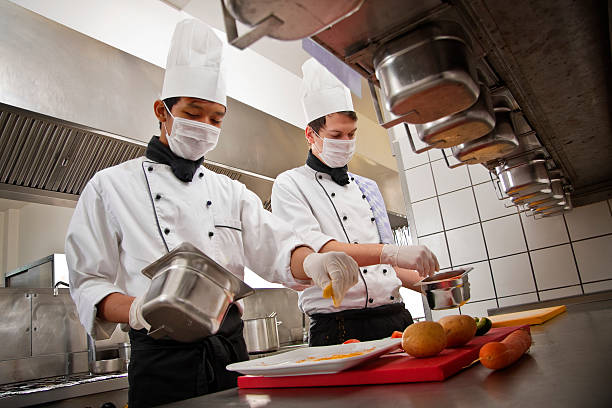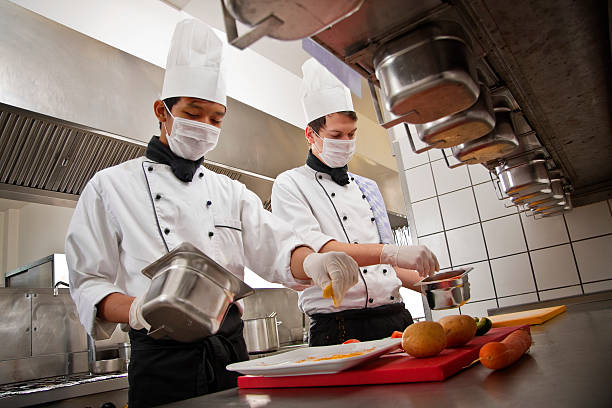3 keys to hygiene in a restaurant kitchen

Professional Chef teaching young culinary student the art of cooking. All images shot in a hotel's commercial kitchen.
3 keys to hygiene in a restaurant kitchen
Establishing hygiene measures in your restaurant is essential for various reasons: by law, you need them to operate and they allow you to take care of your team and your guests. Train your staff and make sure these rules are followed at all times.
Establishing hygiene measures in your restaurant is essential for various reasons: by law, you need them to operate and they allow you to take care of your team and your guests. Train your staff and make sure these rules are followed at all times.

Hygiene measures in a restaurant are the set of parameters and practices that guarantee the preparation of food free of any condition that could put the health of consumers at risk. These measures are essential during the purchase of raw materials, storage, production, plating, and service.
Maintaining food safety depends on at least three main parameters:
1. Cleaning and disinfection of food
Once you have made effective purchases and you gain good quality raw materials, it is time to correctly handle each of your supplies.
All ingredients may contain microorganisms and agents that may be harmful to health. Be sure to follow these 7 general rules for cleaning and sanitizing food:
- Perform hand washing for at least 20 seconds.
- Wash the products.
- Use a brush with those hard-skinned fruits and vegetables.
- Disinfect following the instructions for the use of your solution.
- Dry fruits and vegetables with a clean cloth or paper towel.
- Discard the leaves or outer layers of spinach, lettuce, onions, etc.
After cleaning and disinfecting the food, guarantee the same hygiene standards during the rest of the preparation. Some points that you should not forget are:
- Always use potable and safe water.
- Maintain good inventory control so as not to consume expired food.
- Store all your supplies according to their corresponding temperature, labeled and sealed.
- Guarantees adequate cooking for each type of food.
- Avoid that your preparations spend a long time within the dangerous temperature zone (5-60°C)
2. Personal hygiene in the kitchen
In addition to caring for food safety, it is necessary to establish personal hygiene parameters in the kitchen. Each collaborator involved in the handling of your raw material reaches the kitchen and takes care of its cleanliness.
Consider the following measures and share them with your staff:
- Bathe daily and wear a clean and complete uniform.
- Avoid wearing makeup or jewelry.
- Perform constant hand washing.
- Keep your nails short, clean, and without nail polish.
- Keep long hair tied up and beard trimmed.
- Use personal protection elements in the kitchen, such as caps and hairnets, masks, gloves, etc.
- No smoking, eating, or chewing gum in the kitchen area.
- Avoid touching your face or hair during food preparation.
- Cover yourself correctly when sneezing or coughing.
- Suspend work in case of illness.
3. Cleaning of kitchen utensils and equipment
The entire kitchen must be clean before service begins. This includes floors, walls, work surfaces, utensils, and equipment. The most important thing is to select those responsible for each area and know the frequency with which you should carry out these cleanings.
There is equipment that can be washed and disinfected once a week or monthly, but there are others that need more constant professional cleaning. Get to know them and remember that detergents, disinfectants, and other chemical agents should never come into contact with food:
FROM HERE ARE
Cleaning of kitchen utensils and equipment daily
- Keep the floors clean.
- Cleaning walls with splashes or dirt.
- It is necessary to frequently clean and disinfect utensils and equipment such as grills, griddles, burners, toasters, slicers, fryers, microwaves, pans, pots, knife sets, cutlery, and boards.
- Follow these steps to ensure good surface cleaning throughout the shift:
- Eliminate large debris.
- Rub the surface with a detergent solution.
- Rinse with clean water.
- Apply disinfectant.
- Dry the area with a clean paper towel.
Cleaning of kitchen utensils and equipment weekly - Washing of ovens, refrigerators, freezers, and extractor hoods.
- To clean it, you must empty and momentarily disconnect this equipment.
- Remove all moving parts and clean them with soap.
- Spray the interior with a detergent solution.
- Add some degreaser.
- Rinse with clean water and dry the area.
- It is important to follow the recommendations and instructions for washing and cleaning each piece of equipment to ensure its proper functioning according to its specifications.



